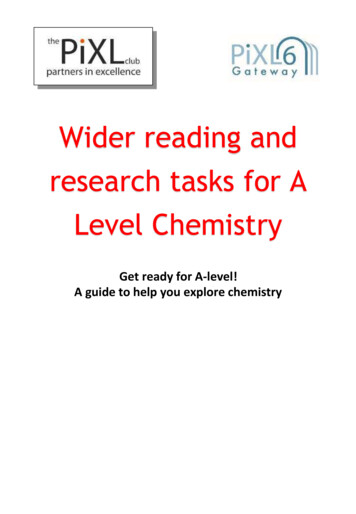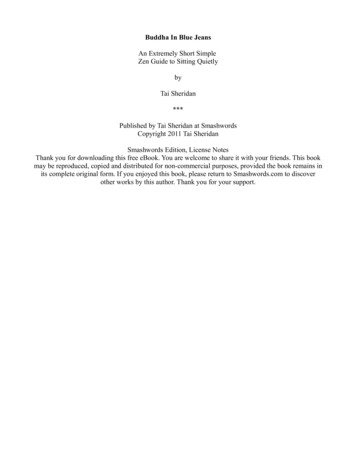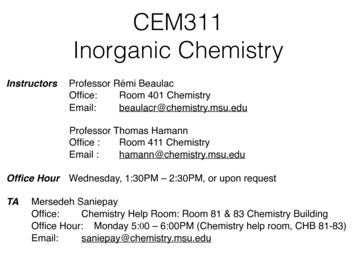
Transcription
Experiment 14Chemistry of Blue Jeans:Indigo Synthesis and DyeingE14-1
E14-2The taskThe goal of this experiment is to synthesise the vat dye, indigo, and compare the propertiesof cloth that has been dyed with indigo and a mordant dye, alizarin red S.SkillsAt the end of this laboratory session you should be able to: vacuum filter, accurately weigh out samples.Other outcomesYou will learn how to synthesise indigo.You will learn how to dye cloth using a vat dye and a mordant dye.You will observe the colours of different divalent metal ion complexes of a mordant dye.You will test and compare dyed material for solubility and fading.The AssessmentYou will be assessed on your ability to isolate solid products using vacuum filtration. SeeSkill 6.2.
E14-3Introduction (History)IndigoThe blue dye indigo has been used in India for about 4000 years. It can be extracted fromthe plant Indigofera tinctoria. Phoenician traders and migrating peoples graduallyintroduced this dye to the Mediterranean area and its use spread across Europe. In NorthernEurope from the Bronze Age (2500 – 850 BC) onwards, people used a blue dye, woad,from the plant Isatis tinctoria. It has since been discovered that this plant contains thechemical indigo, but due to other compounds in the plant it is not as ‘pure’ blue as that fromthe plant Indigofera.Indigo is termed a vat dye. Its preparation involved fermenting the juice of the crushedplant and then treatment with urine. (You will not have to do this today.) For dyeing, fibrewas dipped into a bath (or vat) containing the initially colourless dye and then hung out inthe sun to produce a blue insoluble dye on the fibre.In 1865, the German chemist Johann Friedrich Wilhelm Adolf von Baeyer began workingwith indigo. In 1880, his work resulted in the first chemical synthesis of indigo and threeyears later the announcement of its chemical structure. BASF (Badische Anilin- und SodaFabrik) developed a viable manufacturing process that was in use by 1897, and by 1913synthetic indigo had almost completely replaced natural indigo. In 2002, 17000 tons ofsynthetic indigo was produced worldwide.DenimDenim, a heavy woven cotton fabric, originated in the ancient textile centre of Nimes,France, and was called “serge de Nimes”. Columbus is reported to have used denim for hissails on the Santa Maria. At approximately the same time in India, the sailors of Dhungawere using denim material for their pants, which became known as dungarees. Later on,the word “jeans” came into usage, because working men from Genoa, Italy, had adopted thepractice of wearing denim trousers.After the Californian gold rush of 1849, Levi Strauss, an unsuccessful miner, became richby making denim pants for the more successful miners. The first Western “Levis” jeanswere born. Over the next hundred years they remained working pants, but in the 1940’sdenim started to be used in sportswear and rainwear. Since 1960, the jeans business hasundergone a transformation from tough, cheap clothing to a fashion conscious market.Around 1970, American youth adopted denim as their favourite material.AlizarinAlizarin was already used for dyeing cloth in Asia and Europe in ancient times. It has beenfound in the excavations at Pompeii and in Egyptian textiles from as early as 1567 BC andin Corinth from 146 BC. In 972 AD, alizarin was first used on paper in ink for a marriagecertificate of Byzantine Empress Theophano, then later as a pigment in paint. In theAdvocates Library in Edinburgh, alizarin paint has been identified in an illustrated bookdated 1465-1489.
E14-4Alizarin is found in the root of the madder plant, or more precisely in the root of theMediterranean and Asian plant Rubia tinctorum. The plant was usually harvested threeyears after planting for maximum dye yield. It was then uprooted and left to dry, put inlarger piles for 2-3 days and then dried in warm-air drying houses. The dried roots werecrushed and separated from the bark and ground into a fine powder. The juice of the rootsof some species of the madder plant must be fermented for 1-2 years before it can be used.Other species, which have a significantly higher quality, can be used straight away, but ingeneral it is better if stored first.Sir William Henry Perkin (1838 – 1907), at 18 years of age, synthesised the first purelysynthetic dyestuff (mauveine or aniline purple), from chemicals derived from coal tar,whilst trying to synthesise quinine.In 1869, Perkin also synthesised alizarin.Unfortunately for Perkin, the German company BASF beat him to the patenting process byone day! It was decided that Perkin would sell to Britain (400 tonnes a year) and BASF tothe rest of the world.The Birth of the Pharmaceutical IndustryA medical student, Paul Ehrlich (awarded the Nobel Prize for Medicine in 1908), had beenimpressed with the ability of certain dyes to stain tissues selectively. Ehrlich believed thatstaining was a result of a chemical reaction between the dye and the tissue. He thereforelooked for dyes that had an affinity for micro-organisms, hoping that the dye could bemodified to become specifically lethal to the micro-organisms.Ehrlich’s research was looking for “magic bullets” – chemicals that would be toxic toinfectious micro-organisms, but harmless to humans. In 1907, he discovered the curativeproperties of the dye, Trypan Red I, when used against trypanosomiasis (of which Africansleeping-sickness is one form), and in 1909 he discovered Salvarsan as a remedy forsyphilis. Through these discoveries he ushered in the new field of “chemotherapy”.In 1935, the daughter of Gerhard Domagk, a doctor employed by the German dyeconglomerate IG Farben (Interessen-Gemeinschaft Farbenindustrie), contracted astreptococcal infection from a pin prick. As his daughter neared death, her father decidedto give her an oral dose of a dye called Prontosil, which had been developed in IG Farben’sBayer labs. Tests had shown that it inhibited the growth of streptococci in mice. Within ashort time the little girl recovered. Domagk’s gamble not only saved his daughter’s life, butit initiated a new and wonderful productive phase in modern chemotherapy.
E14-5Introduction (Chemistry)IndigoToday you will be synthesising indigo using the Baeyer-Drewson reaction, as shown inFigure 1. In this and subsequent figures we have used stick notation, a shorthand method ofdrawing complex organic molecules. (See Skill 13 for a full description of stick notation.)The lines represent bonds and, unless otherwise specified, the atoms at the ends of all bondsare carbon. Whenever a carbon atom has fewer than 4 bonds, the number of hydrogensbonded to it can be calculated - carbon always has a valence of 4 and the undrawn bondsare assumed to be bonds to hydrogen.The Baeyer-Drewson reaction was developed by von Baeyer in 1880 to produce the firstsynthetic indigo. It works well for small scale reactions, but is not used today in industryfor producing large quantities of indigo.OO2O H2NOHH2-nitrobenzaldehyde2 CH3COOH NNO2acetoneHacetic acidOindigoFigure 1: The Baeyer-Drewson reaction of 2-nitrobenzaldehyde with acetone in basicconditions to produce indigo.Indigo is not soluble in water. Therefore, to dye cloth, the indigo needs to be firstconverted into a water soluble form. In this experiment, you will synthesize the insolubleindigo dye and then convert it (via a reduction reaction with sodium dithionite) to thecolourless and water-soluble leucoindigo or indigo white, as shown in Figure 2. When thecolourless leucoindigo comes into contact with air it oxidises back to the insoluble blueindigo compound.OHNOindigoHNNa2S2O4[O]NHOHNH HOleucoindigo (indigo white)Figure. 2: The reaction showing the conversion of the insoluble blue indigo dye to thecolourless water-soluble leucoindigo or indigo white.
E14-6Alizarin Red SA mordant dye (e.g alizarin red S) cannot bond or be fixed directly to a fabric. Instead, thefibres of the fabric are first treated with a metal salt solution (e.g. aluminium, chromiumand copper salts, etc) called a mordant. The metal ions in solution form strong bonds withthe fibre and then subsequently with the applied dye, thus binding the dye indirectly to thefabric. The final colour of the dyed fabric is dependent on both the mordant (metal ion) andthe dye.Figure 3 shows the chemical structure of cellulose, a polymer made from D-glucosemolecules. Cotton is essentially pure cellulose. When treated with a mordant, the hydroxylgroups on the cellulose bond to the metal ions, and then, when alizarin red S is added, itbinds to the metal as shown in Figure 4, dyeing the cotton fabric.H OH645OHO3HH OHH O24O1OH5HO3HH6HHH OHH O2641OOH5HOH3HH O2OHH1OHFigure 3: Structure of cellulosef abricOOOM n OOOHOHOHOSO3NaFigure 4(a): Structure of alizarin red SOFigure 4(b):SO3NaThe metal ion bonds toalizarin red S and cellulose
E14-7SafetyChemical Hazard Identification2-nitrobenzaldehyde – hazardous. Irritant, moderate toxicity. Avoid eye or skincontact and dust generation or inhalation.acetone – hazardous. Highly flammable, irritant, low to moderate toxicity.ethanol – hazardous. Highly flammable, low to moderate toxicity, irritant.sodium hydroxide – hazardous. Highly corrosive and hygroscopic, severe irritant.sodium dithionite – hazardous. Moderate toxicity, slightly corrosive, irritant.aluminium sulfate – hazardous. Slightly corrosive, irritant.calcium chloride – non-hazardous, irritant.copper(II) sulfate – hazardous. Toxic, irritant.iron(II) sulfate – hazardous. Moderate toxicity, irritant.cyclohexane – hazardous. Highly flammable, moderate toxicity, irritant.diethyl ether (ether) – hazardous. Toxic, irritant. Avoid eye or skin contact andvapour inhalation. Highly flammable liquid and vapours.5% v/v hydrogen peroxide – hazardous. Irritant.alizarin red S – non hazardous.indigo - non-hazardous. Low toxicity.Risk Assessment and ControlModerate risk.Glass stirring rods are liable to break and cause serious cuts.Organic solvents are a fire hazard and are easily absorbed through inhalation. Theymust be kept in the fumehood.Waste DisposalAny remaining iron and calcium solutions can be disposed of down the sink. Anyremaining copper and aluminium solutions must be disposed of in the “Heavy Metal”waste container in the fumehood. Any remaining alizarin red S solution may bewashed down the sink. The solid indigo waste is to be discarded in the “Indigo”waste container in the fume hood. Ether and cyclohexane waste is to go into the nonchlorinated organic waste container in the fume hood.
E14-8ExperimentalThis experiment is to be carried out in pairs.Notes: All volumes of solutions should be measured in either a 10 mL or a 100 mLmeasuring cylinder as appropriate.The pieces of cloth should be dried by leaving them on a piece of paper towel in the fumecupboard.Part ASynthesis of indigo(A1) Use a top loading balance (Skill 3.1) to weigh out 0.5 g of 2-nitrobenzaldehyde intoa clean 100 mL beaker and dissolve it in 10 mL of acetone.(A2)Dilute the solution with 20 mL of deionised water.(A3)Measure out 2.5 mL of 2 M sodium hydroxide (NaOH).(A4) Using a glass rod, stir the solution in the beaker vigorously and carefully pour in thesodium hydroxide. The solution should immediately turn a deep yellow, then becomedarker and within 20 seconds a dark precipitate of indigo should appear.(A5)Continue to stir the mixture for 5 minutes.(A6)Collect the purple-blue precipitate in a Büchner funnel (Skill 6.2).(A7) Wash the product with deionised water until the washings are colourless (approx.100 mL of water needed). Then wash with 20 mL of ethanol.(A8) Take out 100 mg of the indigo (about ½ the size of a pea) and place in a clean100 mL beaker for vat dyeing the cotton.Part BVat dyeing of cotton(B1) To the beaker with the indigo sample, add a few drops of ethanol and make a pasteby rubbing the mixture with a glass rod.(B2) Add 1 mL of deionised water to the paste and make a suspension by stirring with aglass rod.(B3)Add 3 mL of 2 M sodium hydroxide solution to the suspension.(B4) Use a top loading balance (Skill 3.1) to weigh out 0.6 g of sodium dithionite intoanother clean 100 mL beaker and then dissolve it in 20 mL of deionised water.(B5) Add the sodium dithionite solution to the beaker that contains the indigo dye andthen cover the beaker with a watchglass.(B6) Heat the mixture to 50 C on a magnetic stirrer hotplate, and as soon as a clearyellow or green solution is obtained, add 40 mL of deionised water.(B7) Immerse five small pieces of cotton in the ‘vat’ and leave for 1 hour at 50 C,occasionally moving the fabric to ensure even dyeing.
E14-9(B8)Proceed with Part C during this 1 hour waiting time.(B9) Remove the cotton pieces with metal tongs and squeeze dry. Wait until it changescolour ( 30 s), then remove any residue of indigo which is not incorporated into the fibresof the cloth by rinsing the cotton under the tap until the washings are clear. Dry the piecesof cloth.(B10) When the pieces of cloth are dry, attach one to your logbook. The remainingpieces will be used later for testing the colour fastness of the dye.Part CDyeing with the mordant dye alizarin red SDo not touch the dye with your fingers.In this part of the experiment you will discover how to use alizarin red S to dye pieces ofmaterial various colours by varying the mordant (metal ions).(C1) Make up a series of stock solutions of the metal ions which will be used as themordant. You will need four clean 100 mL beakers. Label each beaker appropriately. Cu2 : Dissolve half a nickel spoonful of CuSO4 in 40 mL of deionised water. Fe2 : Dissolve half a nickel spoonful of FeSO4 in 40 mL of deionised water. Al3 : Dissolve half a nickel spoonful of Al2(SO4)3 in 40 mL of deionised waterand add 1 mL of 2 M NaOH. Ca2 : Dissolve half a nickel spoonful of CaCl2 in 40 mL of deionised water.(C2) In a clean 100 mL conical flask, dissolve half a nickel spoonful of alizarin red S in80 mL of deionised water.(C3)Pour 10 mL of the alizarin red S solution into a clean 100 mL beaker.(C4) Using metal tongs, take a new piece of cloth and dip it first into the copper mordantand then into the alizarin solution. Make sure that it is completely covered.(C5)dry.Using the tongs, squeeze as much solution as possible out of the material and blot(C6) Wash the remaining (now contaminated) alizarin red S solution down the sink.Rinse the 100 mL beaker using a small amount of deionised water.(C7)Repeat steps (C3) - (C6) with the remaining mordants (Fe2 , Al3 and Ca2 ).(C8)Repeat steps (C3) - (C6) using tap water as the mordant.(C9)Repeat steps (C3) - (C6), but without using any mordant, to dye 5 pieces of cloth.(C10) Repeat steps (C3) - (C6) with a mordant of your choice to dye 4 pieces of cloth.This is for testing the colour fastness of the dye later on.(C11) When the cloth has dried, wash it with cold water until the water is clear. Dry thecloth again.
E14-10For your logbook:Record your results in a table and attach your dyed cotton samples (that are not requiredfor testing) in your logbook.Include what ions you think, based on your results, are present in tap water.Part DTesting the dyed cotton materialIn this part of the experiment you will investigate how the dye can be removed from thematerial, i.e. which solvents can dissolve the dye. You will also investigate the resistanceof the dye to fading.Solubility of the Dye(D1) On your bench, make a cold water bath. In the fumehood make up a cyclohexanebath and an ether bath as shown in Figure 5. (Ether and cyclohexane are non-polar organicsolvents, water is a polar solvent.)Watchglass100 mL beaker30 mL solvent (ether,cyclohexane or water)Samples of materialFigure 5: Diagram of a solvent bath.(D2) Place one of each of the following dyed samples into each bath and leave for 10-15minutes. cloth dyed with alizarin red S only (C9); cloth dyed with a single metal mordant (C10); cloth dyed with indigo (Part B).(D3) Observe the colour of the solution around each piece of cloth, remove the pieces anddry them.(D4) Dispose of the ether and cyclohexane baths in the non-chlorinated organic wastecontainer.For your logbook:Compare the colour of the cloth that has been soaking in the solvent baths with the originalpiece of cloth, tabulate and record the results and attach the faded samples in yourlogbook. You should note whether the dye is soluble (most of the dye was removed from thecloth), slightly soluble (a little bit of the dye was removed from the cloth) or insoluble (nodye was removed from the cloth).
E14-11FadingTo test the dye for fading, we will speed up the process by using a mild bleach, dilutehydrogen peroxide solution.(D5)On your bench make a solvent bath with 30 mL of 5 % v/v hydrogen peroxide.(D6) Place one of each of the following dyed samples into the bath and leave for 10-15minutes. cloth dyed with alizarin only (C9); cloth dyed with a single metal mordant (C10); cloth dyed with indigo (Part B).(D7) Observe the colour of the solution around each piece of cloth, remove the pieces anddry them.For your logbook:Compare the colour of the cloth that has been soaking in the solvent bath with the originalsample of cloth, tabulate and record the results and attach the faded samples in yourlogbook. You should note if the hydrogen peroxide has caused any fading. (Was there nofading, a little bit of fading or a lot of fading?)Group DiscussionA dye is something that has the following properties: highly coloured, so that it can be used in small concentrations; capable of being attached strongly to the fabric, so that it won’t wash out; resistant to fading and discolouring.What other property should a commercially used dye possess?Did the indigo and alizarin red S dyes fulfil these qualities? List the pros and cons for eachof these dyes.Was there a difference in the above qualities between the alizarin red S dye when there wasmordant used and no mordant?References1. M. Sequin-Frey, J. Chem. Ed., 58, 301 (1981).2. T. W. Graham Solomons, “Organic Chemistry”, 4th Ed., p 915 (1988) John Wiley &Sons.3. L. M. Hardwood, C. J. Moody and J. M. Percy, “Experimental Organic Chemistry,Standard and Microscale”, 2nd Ed., p 622 (1999) Blackwell Science.4. M. Livneh, Educacion Quimica, 16, 534 (2005).5. M. V. Orna, A. W. Kozlowski, A. Baskinger and T. Adams, ACS Symposium series565.
The blue dye indigo has been used in India for about 4000 years. It can be extracted from . alizarin paint has been identified in an illustrated book dated 1465-1489. E14-4 . . (Chemistry) Indigo Today you will be synthesising indigo using the Baeyer-Drewson reaction, as shown in










